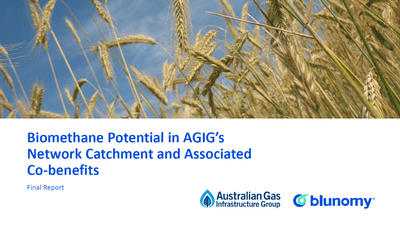Mapping the biomethane potential around gas networks and quantifying the associated co-benefits

Blunomy is sharing the approach and results of a project completed for AGIG, an Australian gas network operator, to quantify the biomethane potential within a 50 km catchment of their assets and the associated co-benefits linked to job creation, avoided carbon emissions from natural gas displacement, diversion of waste from landfill and contribution to a circular economy.
Biomethane features strongly as one of the key pillars in driving renewable gas supply for gas network operators in Australia. Understanding the quantity and location of specific bioresources that can be converted to biomethane via anaerobic digestion plays an instrumental role in identifying opportunities to supply the gas network. Blunomy's innovative approach that harnesses our data analytics capabilities included:
- Granularizing the feedstock streams suitable for anaerobic digestion using land-use datasets to determine the quantity and location within a 50 km catchment of AGIG's network assets
- Leveraging public and internal datasets on bioresources from various waste streams across Queensland, Victoria and South Australia to develop a theoretical biomethane potential
- Enhancing the reality of this biomethane potential through interviews with industry experts to determine a recoverable biomethane potential across two scenarios (Business-as-usual and Policy Enabled)
- Developing heatmaps reflecting the potential of different feedstocks available within 50 km of AGIG's network catchment